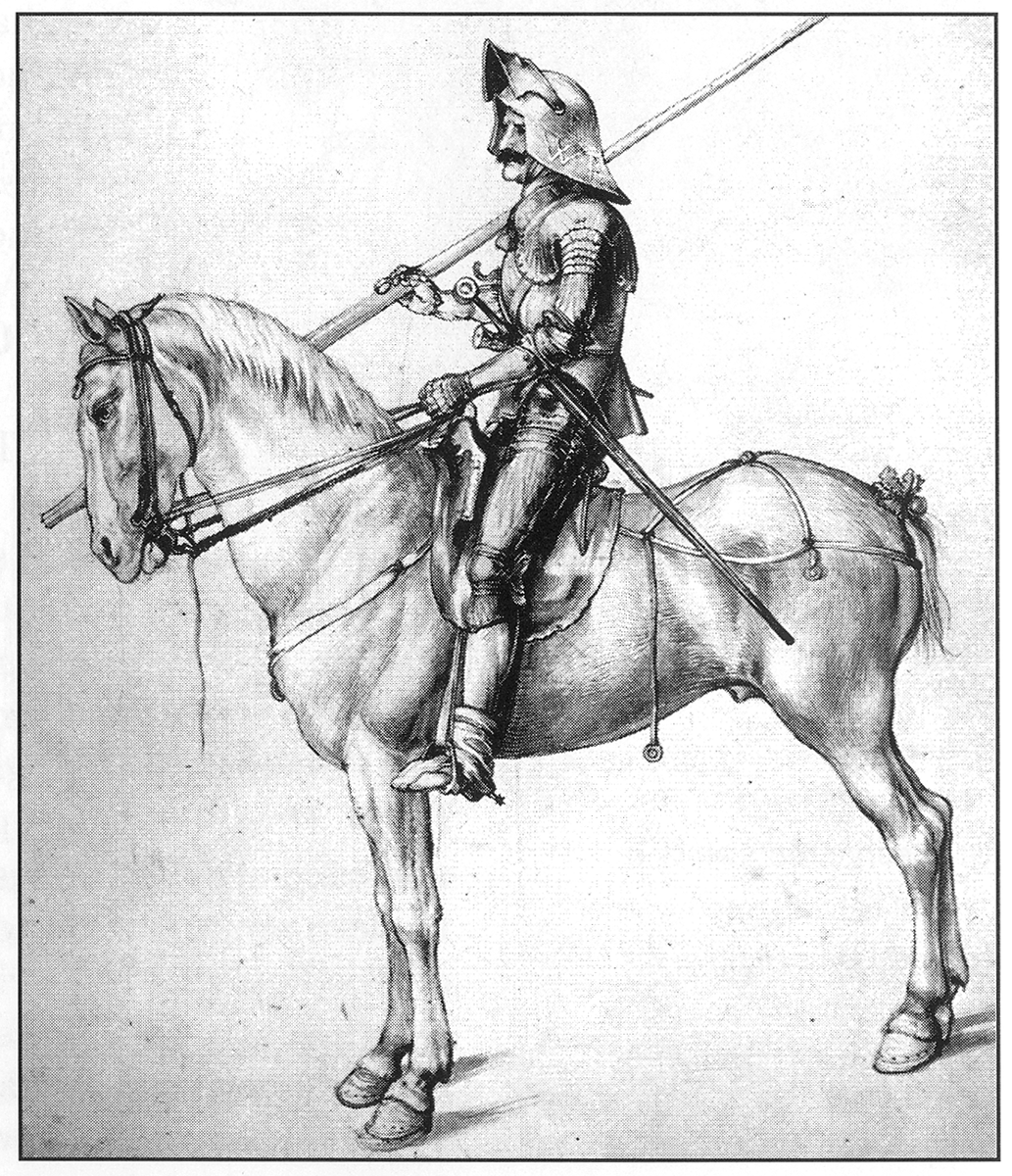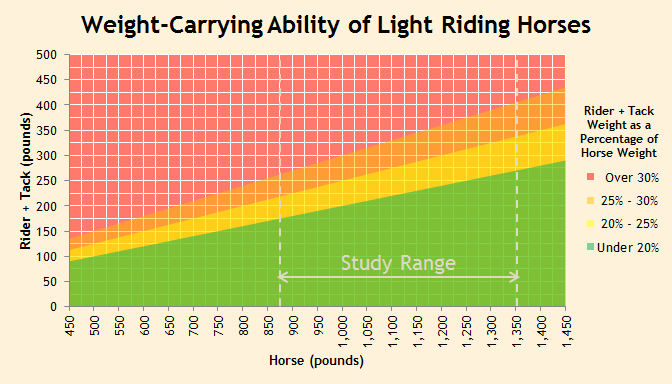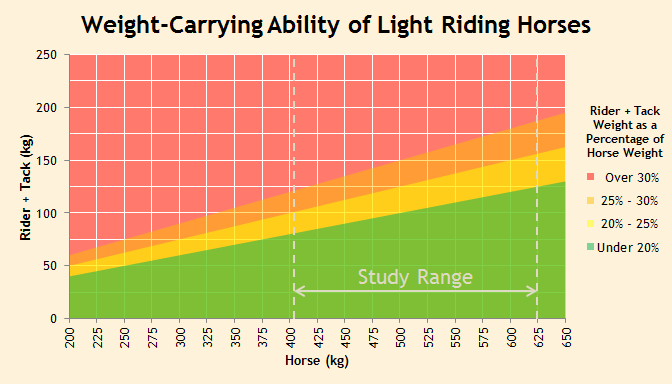Jared Lee’s cartoon makes light of what is pretty obvious to most of us: the horse is far better equipped to carry people than the other way ’round! And yet, as the size of our population continues to increase, the shrinking weight difference between horse and rider is definitely having an impact on the horse world. For example, one of the owners of the guest ranch I frequent in Arizona (the White Stallion Ranch) told me that although they don’t have an upper weight limit for riders (unlike most guest ranches, by the way), they’ve had to buy increasingly-larger horses to keep up with the changes in guest size. Likewise, my travels to various horse farms have led me to the same undeniable conclusion: there is a growing number of larger riders.
At this point, I realize some of you may be thinking “Oh no! I don’t think I like where this is headed!” But as I’ve mentioned before, my commitment is to the long-term comfort and soundness of the horse. And that includes not only proper hoof care, but nearly every aspect of equine management. So please understand that I’m just delivering information; what you choose to do (or not do) with it is up to you! On we go…
A few years ago, this subject caught the attention of a couple of our equine professors who were interested in finding research in support of some particular method of determining the maximum weight-carrying capability of a horse, particularly the common assertion that a horse should carry no more than 20% of its body weight. But as with many of the horse world’s popularly-held ideas, they found very little actual data to support any specific method or assertion. And so they decided to design a study of their own to investigate the effects of a horse carrying 15%, 20%, 25%, and 30% of its body weight. The resulting paper, entitled “Evaluation of Indicators of Weight-Carrying Ability of Light Riding Horses” (DM Powell et al) was published in the Journal of Equine Veterinary Science (Vol 28, No 1 (2008)). Their publication forms the basis for the information presented in the first part of this article.
I won’t go into great depth on their methodology here, but a brief summary is as follows:
- Eight fit, mature horses – geldings and mares – of light horse type were used, with feed intake adjusted weekly to maintain initial body weight
- During the course of the study, the horses were housed individually in stalls, with daily turnout
- Each horse carried 15%, 20%, 25%, and 30% of their body weight in a series of randomly-assigned trials, with 14-day rest periods between trials
- After a standardized warmup, each horse performed a standardized exercise test with one of three experienced riders, with the load adjusted by means of lead weights added symmetrically to the saddle
- Twenty-four hours before and after each exercise test, muscle soreness and tightness changes were evaluated by the same professional animal massage therapist in 40 consistent locations on each horse
- Blood samples were collected immediately before and after exercise, with additional samples taken 10 minutes, 24 hours, and 48 hours after exercise
- Heart rate, respiration rate, and rectal temperature were measured immediately before and after exercise
Both the subjective and objective results showed statistically-significant differences indicating greater work rates when the horses carried 25% and 30% of their body weight compared to 15% and 20%. More importantly, when horses carried 30% of their body weight, their serum creatine kinase activity – an indicator of skeletal muscle damage – was elevated immediately after exercise, and remained higher when measured 24 and 48 hours after exercise. So the recommendation that a horse carry no more than 20% of its body weight does, indeed, seem to have some defensible logic behind it!
For heavier riders, then, it might seem logical to use larger horses, right? Well, unfortunately, only to a point, because there’s also arguably an upper limit beyond which a horse’s congenital soundness is in question. Read what Dr. Deb Bennett, noted equine anatomist and author, has to say about equine size and soundness in Principles of Equine Orthopedics –
Before horses were brought into domestication more than 5,000 years ago, the species averaged 13 hands, 2 inches in height and around 800 lbs. Until as late as 1820, horses over 15 hands, 2 inches and about 1100 lbs. were an absolute rarity – and this, by the way, is the maximum size that any wild equine ever attains. Only after the advent of railroad transport did teamsters see an advantage to utilizing cart and carriage horses that were in the 16- to 17-hand range and drafters going as high as 2200 lbs. (And no – despite what you may think you have learned from Hollywood, there were no knightly chargers as big as the modern Shire; the Medieval “Great Horse” stood 14 hands, 2 inches and weighed around 1000 lbs.). The modern Shire is twice as massive as the largest wild equine that ever lived, and the average riding horse which stands 16 hands and weighs 1400 lbs. is itself “pushing the design envelope”….It is sheer foolishness not to recognize massiveness as a significant contributor to abnormalities of the bones, joints, ligaments, tendons, and dentition of modern horses. A good rule of thumb: any horse standing over 16 hands, 2 inches, or weighing in excess of 1450 lbs., is automatically and congenitally unsound for any use involving prolonged trotting, cantering, or jumping. In terms of horseshoeing, even when large horses are used for walk-activities such as pulling wagons or other heavy loads, their massiveness implies a need not merely for correct work but for constant orthopedic prophylaxis or “preventive and supportive medicine.”

Drawing of a mounted knight prepared for battle ca. A.D. 1500 by Albrecht Durer. Note the relatively small size of the horse vs. rider, and the evidence of strain on the horse’s back. From Conquerers: The Roots of New World Horsemanship by Dr. Deb Bennett.
Now, I realize some of you may be inclined to argue that certain breeds have denser bones than others, and are therefore better equipped to carry heavier riders. But Dr. Bennett also did some measurements and calculations of bone density using skeletons at the Smithsonian Institution, with the following results:
- Horses that weighed (in life) 1000 lbs. or less had normal bone density. There was no consistent trend as to breed; they all fell within a single, fairly tight, cluster.
- Horses that weighed 1500 lbs. or more had below-normal bone density, and although there were a few individual exceptions, the density tended to drop with increasing weight.
- Horses between these two weights showed a weaker tendency for below-normal bone density. The majority of animals had normal bone density, but there were some which were as low as the lowest in the heavyweight group.
So although some breeds and individuals obviously have larger-diameter bones than others, and are therefore probably better suited to carrying more weight than other breeds, there’s no scientific basis to support the notion that, for a given bone diameter, the bones of a particular breed are stronger than those of another breed. In fact, based on Dr. Bennett’s evidence, one might argue that the less-dense bones of very large horses are probably weaker on a per-inch-diameter basis, in spite of their being bigger.
I also feel compelled to mention two other factors affecting weight-carrying ability:
- The horses used in the study were fit horses. So if your horse is out of shape and heavy, it seems logical that some percentage of that excess weight must be deducted from his weight-carrying ability. Because the extra body weight is fairly evenly distributed, it’s probably not the full amount, but I’m willing to bet that it’s at least 50% of the excess amount. For example, if his ideal weight (Body Condition Score of 5) is 1,000 pounds, but he weighs 1,100 pounds instead (Body Condition Score of approximately 6), his weight-carrying ability for rider and tack (assuming a 20% maximum load) would be reduced from 200 pounds to 150 pounds.
- There’s no weight-carrying “bonus” for riders with good equitation skills, but the poorer the rider, the more of a reduction in weight-carrying ability would seem to be necessary to account for the added weight moving out-of-sync with the horse, which increases peak forces (and therefore strain).
I might also add that although proper foot care is always important for long-term comfort and soundness, Dr. Bennett’s research points out the absolute necessity of it for larger horses. So be certain to use a hoof care provider who not only truly understands the concepts of correct hoof form and function, but who also appreciates the necessity of minimizing unnecessary stresses on these horses’ joints by keeping them barefoot and properly trimmed. That will give your horse the absolute best chance at long-term comfort and soundness.
To help you more quickly determine a given horse’s weight-carrying ability, I’ve created the following charts – in pounds and kilograms – that cover a range of horses from small ponies to those at the upper limit of Dr. Bennett’s recommendation –
I’ve also put printable versions of the charts here (pounds) and here (kilograms), so print one out and hang it in your barn. But don’t be too surprised if it makes some people uncomfortable! For our horses’ sake, it would be far better if we were all “in the green,” but I realize a great many of us are not. So please carefully consider what’s best for all concerned parties. And keep in mind that one fairly simple solution for many riders may be to get rid of that 40-pound Western saddle!
Meanwhile, guess I’d better think about doing away with the Fanta…


